- Submissions

Full Text
Evolutions in Mechanical Engineering
Recent Developments and Scope of Electrochemical Micro Machining for Inorganic Materials
Soundarrajan M1*, Thanigaivelan R1, Prakash R2, Senthilkumar R1, Deepa D1, Yuvaraj T1, Aravindkumar D3 and Duraiselvam S3
1Department of Mechanical Engineering, Muthayammal Engineering College (Autonomus), India
2Department of Mechanical Engineering, AVS College of technology, India
3Department of Mechanical Engineering, The Kavery Engineering College, India
*Corresponding author:Soundarrajan M, Department of Mechanical Engineering, Muthayammal Engineering College (Autonomus), Rasipuram, India
Submission: January 03, 2022;Published: June 30, 2022

ISSN 2640-9690 Volume4 Issue2
Abstract
Micromachining is the technique used to fabricate 2D or 3 D structures on metals in range of micron level. There are different techniques exist in industry for manufacturing the micro components. The Micro-Electromechanical Systems (MEMS) are categorized such as photo lithography, wet and dry etching, Fusion bonding, LIGA and laser micromachining. On the other hand, due to technological growth and increased application of non-silicon-based materials in industry, Non-MEMS based techniques such as Electrochemical Machining (ECM), Electro Discharge Machining (EDM), injection moulding, stamping and extrusion employs effectively. This development in current manufacturing trend is generally recognized that micro manufacturing. The current trend headed for the miniaturizations and micromachining becomes imperative in manufacturing of micro components. In traditional and non-traditional, there are various techniques practiced in manufacturing sector for micro components production. Based on operating principals such as mechanical, thermo electric, electrochemical, chemical and biochemical method micro machining techniques are classified. In that some significant techniques are discussed in this section.
Keywords: Micromachining; Electrochemical; MEMS; EDM; ECM; Inorganic materials
Traditional Micromachining
Traditional micromachining refers to micromachining where tools fixed with the spindle moves in high speed, remove metal from the work pieces as chips. Based on the applications various machining are performed in traditional method such as micro drilling, micro turning, micro grinding, micro drilling etc. All those methods are adopted with moving tools which is operates through external forces. Also machining accuracy perceived according to the operating speed, tool material, shape of the tool, work piece structure, chip formation and feed rate. It has wide range of application in modern engineering fields such as automobile, electronics and medical.
Laser Micromachining
Laser Micromachining (LBMM) is removes metal by the application of high energy radiation (ablation mechanism) as a tool. The high energy light focused on a point of the work piece which turns the work to vaporize and melt. The hole diameter range to be between micron to nano scale level. The machining process parameters such as frequency, gas type, wavelength, pressure of gas, work piece thickness and density of energy are the major factor for the accuracy of hole or structure. It’s operated based on two methods such as photo chemical and photo thermal methods. In photo chemical method, laser light falls directly on the work surface which melts the material and injected from the work surface. In photo thermal method, laser energy temperature rises above the melting temperature of work material which turns the work to evaporation [1]. This laser technology employed in micro components manufacturing such as cooling holes, fuel filets, turbine parts and surgical needles. Although, machining cost of this technique is high when compared to the other machining techniques. Also, high operating temperature leads to the cracks formation on the machining surface which may further causes the fracture on the work.
Electric Discharge Micromachining
Electric Discharge Micromachining (EDMM) functions based on the EDM principles. In this Thermal, mechanical, chemical, and electrical effects act together in the machining zone. The high frequency electrical energy is employed to induce spark between the Inter Electrode Gap (IEG) and across them potential difference is used in the dielectric medium. Thus, machining zone gets highly heated and work material begin to melt. The dissolved materials rid out from the IEG through circulated high pressure dielectric liquid. The micro wire is utilized as electrode and its mirror image become copied to the work piece. This system can be machine hard materials such as WC alloys, tool steels and aerospace materials. Also, complex geometrical features can be machined easily with this EDMM. The fabrication of electrodes with any material is effortless one when compared to the traditional machining techniques and high aspect ratio micro holes are possible [2]. The drawback of EDMM is formation of recast layer and poor surface roughness. Since the metal removed from the work in melting state which can propagate the micro cracks on the machined surface. Also, occurrence of tool wear hinders the dimensional accuracy of micro machining.
Electron Beam Micromachining
The Electron Beam Micro Machining (EBMM) process perceived under the vacuum conditions since electron beam may create unwanted chemical reaction with atmospheric air. The high voltage power supply is coupled with the cathode which will produce the required electrons. At very high potential differences between the cathode and anode triggers the electron speed. The highly accelerated electron beam is concentrated at a point which melts the material intensively. At reverse side of work backing material is kept which forms the high volume of gas when react with electron beams. This reaction vaporizes the molten metal from the machined area. EBMM is similar to the laser beam micro machining. However, EBMM is considered for high productivity area when compared to laser micromachining technique [3].
Spark Assisted Chemical Engraving Micromachining
Spark Assisted Chemical Engraving Micro Machining (SPACE) is operating similar to EDM and also named as Electro Chemical Discharge Machining (ECDM). Cathode and anode used as tool and work piece respectively, with in the Sodium Hydroxide (NaOH) electrolyte solution. The potential variations applied between the tool and work which forms the bubbles around the tool. The electrode spark raises the temperature at machining zone and this electrochemical discharge reaction induces the removal of metal form the work piece. SACE is prominent technique to machining the non-conductive brittle materials such as glass and ceramics. In beginning stage these brittle materials are machined through laser technology but high micro cracks were found on machining surface by the researchers. And high aspect ratio machining owns more complications on the accuracy [4]. Hence, in latter the researchers found the SACE, due to thermal assisted chemical etching provide the prominent solution for micro machining. The drawback in SACE is that, only suitable for brittle materials and more studies required to commercialize this technology.
Ultrasonic Micromachining
Ultrasonic micromachining is the process removing metal from the work surface with the application of ultrasonic vibrations. Especially the work materials such as silicon, ceramics and glass are machined through this method. Abrasive slurry jet utilized in between the tool and work piece. The vibrations applied on the tool or work piece for the range of above 20kHz. This vibration impacts the abrasive particles into the work surface which induces the removal of material by mechanical. Nowadays this mechanism used in both conventional and non-conventional methods for manufacturing the micro/macro components due to its high precision [5]. But this process takes long time to machining the metal which reduces the rate of production.
Need for EMM
EMM is basically an anodic dissolution process like electro
plating method. Among the various micromachining techniques,
EMM is considered for the following reasons.
1. No tool wears
2. No residual stress
3. High accuracy can be made
4. No heat affected zone
5. Cost effective
6. Rapid machining time
7. Good surface finish
8. In expensive setup
9. High MR irrespective of hard materialsv
10. Eco-friendly method
Electro Chemical Machining
ECM is the process of removing of material from the work piece in way like reverse electroplating. In this machining process positive and negative terminals connected with anode and cathode respectively. The work piece act as anode and tool act as cathode which is separated using electrolyte solution. Basically, the salt solutions are used an electrolyte solution which could be accelerating the conductance in machining zone [6]. While applying the potential difference on the work and tool, positive metal ions leave the work piece by the oxidization reaction. The positive ions of metal and negative ions of electrolyte attracted each other and forms the hydroxides ions which resulting the precipitate. The electrolyte flushed out between the IEG to remove debris and also, it’s avoided the short circuit of electrodes. The electrolyte supply system contains the filter which helps to remove the dissolved material and circulate the refreshed electrolyte [7]. The IEG maintained constantly during the machining process. The schematic diagram of ECM is shown in Figure 1.
Figure 1:Schematic diagram of ECM Process [8].
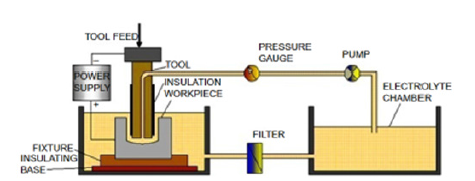
Table 1: Dimensions of the plasma pinch when the nitrogen gas pressure changes in the UNU/ICTP PFF device.
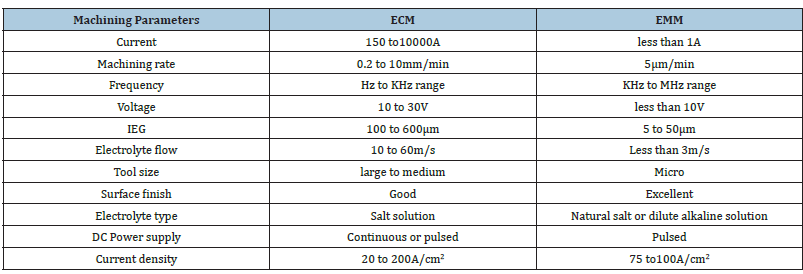
Principle of EMM
In EMM process, material removal controlled by faraday’s law
of electrolysis, which is described that,
i. The quantity of chemical modifications created by
electric current at an electrode is proportional to the amount of
electricity distributed.
ii. The amount of different elements dissolved or deposited
by the same quantity of electricity are proportional to their
equivalent weights.
This law points out the relationship between numbers of electro
removed from the atom and mass of dissolved atom in electrolyte.
The faraday’s law described as,
M = KIt (1.1)
Where,
M = Mass of the atom
K = A / (Z. F) in g / c, electrochemical equivalent of the anode
A = atomic weight of dissolving ions
Z = valance of dissolve ion
I = electric current in amp
t = machining time in sec
Advancements IN EMM
The demand towards the micro components with high precision and good surface finish is increasing day by day over different applications such as automobiles, electronics, medical and biomedical sectors. Thereby research in EMM attracts the researchers with the aim of improving performance. The significant parameters such as tool electrode, electrolyte, electrical parameters and hybrid process are adopted to improve the machining efficiency of EMM. The fish bone diagram illustrated in Figure 2 those strategies taken in EMM [9].
Figure 2: Advanced strategies in EMM [10].
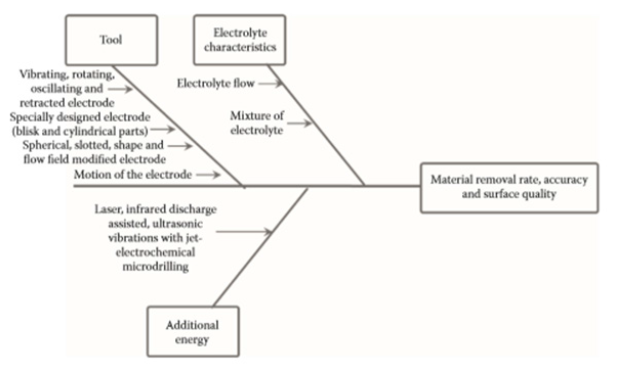
Tool electrode design
The shape of tool electrode plays major role in EMM since the negative mirror image of the tool is produced on the work piece. Familiar and prominent techniques such as Wire Electric Discharge Grinding (WEDG) and electrochemical etching methods are used to fabricate the tool electrode. Commercially available micro pins can be used as electrode. The tool materials such as copper, titanium, and Stainless Steel (SS) could be use but it should be chemically inert, easily available, good machinability and good electrical conductor. Along with those novel strategies are enhanced the EMM performances. In line up with that, to remove the dissolved or machined parts from the machining zone ultrasonic vibration is adopted with the tool holder. This methodology preserves significant improvement in surface quality, accuracy, and machining rate [11]. Also, auxiliary electrodes are proposed to enhance the machining localization effect which results the high accuracy in micro dimples fabrications. For machining the blades, optimal combination of feed rate to tool is proposed by the researchers. Such a way different techniques like, rotating tool, specially designed electrode, spherical, slotted shape, motioned tools etc. are pursued nowadays to enhance the EMM performance.
Electrolyte characteristics
In recent years, researchers approached the EMM with modified electrolyte which gives significant impact on machining performance. Since the electrolytes are act as bridge between tool and work which passes the current to induce the material removal. Therefore, the good accuracy and high machining rate obtained in Stainless Steel (SS) and cemented carbide work pieces using mixed electrolytes such as ammonia with sodium hydroxide, acidified sodium nitrate, and sodium chlorate [12]. The copper nano particles are mixed with electrolyte which breaks the gas layer and ensures the uniform current distributions. Thereby machining rate improved significantly. Also, electrolyte flow patterns such as continues electrolytic jet, pulsating electrolyte and progressive pressurized electrolyte are employed in EMM [13]. All these electrolytes are enhanced the EMM performance by heat transfer, improving machining rate and flushed out the machined partic
Advantages OF EMM Process
EMM found to be a promising technique due to its nature of
machining method. The advantages of EMM are listed below,
1. Hard and Brittle can be machining with high quality of
accuracy and high machining rate
2. Complex structures and high aspect ratio are possible
3. Chemically inert and poor conductive material also can
machine
4. Burr free machining surface
5. No upper layers such as white layer, micro cracks
6. Same tool can be used for long run
7. Non polluted setup
8. 3 D parts can be machine
9. High dimensional accuracy
10. No tool wear occurred
11. Mass production is possible
12. High repeatability and scalability
13. No direct force utilization on machining parts
14. No heat affected zone
15. No residual stresses
16. High tolerance can be obtained
17. Simple experimental setup
18. No need of high voltage power supply
19. Easy handling and compact
Optimization Techniques in EMM
The optimization of process parameters is also playing a major role in the production of quality micro-holes. Researchers are included the Multiobjective Genetic Algorithm (MOGA) optimization technique for improving material removal and optimize the EMM performance. In that excellent MR and better surface roughness is archived high carbon High Chromium Die Tool Steel (HCHCr die tool steel) with the use of copper nano particles mixed sodium nitrate electrolyte [14]. The ECM performance improved significantly while addition external setup such as magnetic flux assisted vibrating tool. The machined products or debris interruption at the machining zone is very much reduced with the use of vibrating and magnetic flux assisted tool electrode which leads to better MR and good accuracy [15,16]. Apart from, reducing mixed electrolyte and hybrid techniques, tool design optimization plays a major role in EMM process. To archive the accurate shape of tool various optimization techniques such as grey relational analysis, NSGA - II, PSO- DF and RSM [17] are used in this process. Although, simple and old ranking optimization techniques such as TOPSIS, GRA, MOORA, VIKOR and COPRAS are attracts the researchers in this field.
Applications of EMM
The industries like automobile, communications, electronics, medical and biomedical sectors provide scope for various types of micro products/features. However, EMM removes the by electrochemical action in atomic level. In this machining depends on the valence electron of work material not to the physical or mechanical characteristics of the work. Thus, EMM could machine any conductive materials regardless with material hardness. The typical applications of EMM technology are discussed below.
Micro Nozzles/
The micro nozzles are fabricated on high temperature resistance steels such titanium, SS and nickel alloys using EMM process. These micro nozzles found applications in injectors used in automobile, aerospace applications, heat transfer systems and various medical applications. The Figure 3(a) shows the SEM image of micro nozzle which is fabricated by EMM process with the use of conical micro tool. The machining conditions for the micro nozzles is 3 V Mv, 30% Dc and 10Mhz Fr. The entry and exit diameter of nozzle is 98.50mm and 51.02mm respectively. The internal wall of nozzle is shown in Figure 3(b). micro nozzle taper has been reduced with increase in micro tool freed rate [17].
Figure 3:SEM image (a) Micro nozzle (b) Internal wall of micro nozzle [17].
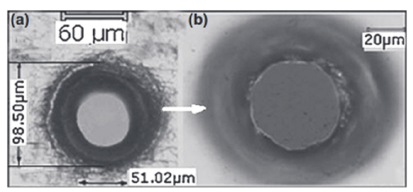
Nozzle plate for ink-jet printer head
Generally micro nozzles are used in ink jet printers which are fabricated through electroforming method on the mandrel (mold). The mandrel used to define the pattern of nozzle and then finished products removed. The pulsating voltage clutches good control over EMM of thin films and foils in the applications of micro manufacturing. The series of flat bottomed conical micro nozzles are fabricated on metal foil with the use of Through Mask EMM (TMEMM) which is shown in Figure 4. This process can be employable to various electrically conducting materials.
Figure 4: Series of flat bottomed conical micro nozzles [9].

Cooling holes in turbine blades
The reason for cooling holes in turbine blade is to obtain maximum heat transfer rate at minimum flow rate of the coolant. The turbine blades are generally made with high melting point materials with super alloy. The lost wax method is employed for casting the cooling holes. Through this technique cavity of serpentine shape is possible. Another method applied the drilling process to provide the blades with cooling holes. These holes are fabricated in the span-wise direction of the turbine blades. In both cases, ribbed surfaces are found on walls of the passage. Although, these techniques grown over the years, but still its challenging task to create the cavities for large scale parts. Hence, the drilling technique is adopted to produce longitudinal holes in blades. Since the conventional technique for these complex shapes is not suitable. Therefore, EMM technique is preferred to other techniques. The Figure 5 shows the micro holes present in turbine blades for creating cooling effect [18].
Figure 5:Micro holes present in turbine blades [18].

3 D micro features
3 D micro features can be machined through EMM with the use of scanning movement of the micro tool at the desired path. The micro hemisphere machine by EMM is shown in Figure 6 which is fabricated on SS 304 material at the machining condition of 6V, 60ns pulse on time and 1ms period with three stages [19]. Micro cylinder was created in first stage and 100nm diameters on the top of cylinder done in the second stage. The quick finish cut run in the last stage.
Figure 6: SEM image of 3 D micro feature fabricated by EMM [19].
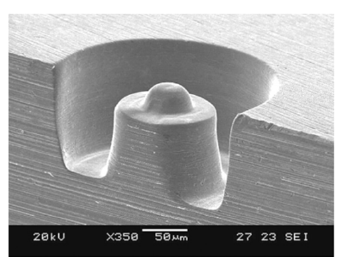
Surface engineering for biomedical implant
Surface microscopic structures are difficult factors that affect application of titanium as a load bearing implant in orthopaedic surgery. EMM can machine titanium with high accuracy using jet electrolyte. Jet EMM is employed to fabricate with high aspect ratio micro holes on titanium work piece for bio medical implants. Jet EMM operates based on the electrochemical reaction in addition with jet electrolyte flows which provide the alternative to other surface micromachining techniques of titanium implants. The adequate micro hole depth of titanium work surface provides the feasible path for bone growth. The components of jet EMM are simple when compared to the TMEMM. The Figure 7 shows the SEM image of micro hole patterns on titanium material which is fabricated in jet EMM process
Figure 7: SEM image of micro hole pattern on titanium alloy [19].

Helium cooled diverters for nuclear reactor
Generally, the nuclear power plants are consisting of various very high temperature operating subsystems. To prevent those systems from temperature helium cooling system is adopted which accompanied with steam generator and heat exchanger to diminish the thermal disturbance in the plant. These diverter’s structures are machined through ECM process. Here specially made tool electrode is employed as cathode and tungsten material is made as anode. The required shape of mask is applied on the work material for electric insulation which protects the areas not to be removed in the electrolyte solution. The Figure 8 (a-d) shows the tool shape, work, machining zone adjustment and machined structure. The Figure 9 shows the tool and machined structure of work prices which is used in He-cooling systems.
Figure 8: Pictures shows the (a) tool (b) tungsten work piece (c) machining adjustment (d) structured work piece [20].

Figure 9: Tungsten disk and structured work piece by M-ECM process [21]..

Micro hole arrays using disk microelectrode array
Disk micro electrode is fabricated through EMM process for producing the micro holes. Multiple micro holes can be produced at a time using array electrodes. Special electrode is fabricated in EMM process which used further for producing the micro holes. The micro electrodes such as 3x3 disk type and 5x5 cylindrical electrode arrays fabricated. Using these tools, micro holes are fabricated on SS materials. Generally, this kind of machining method reduces machining cost and time in mass productions [23]. Figure 10 (a & b) shows the shows the micro holes entry and exit sides machined through cylindrical tool.
Figure 10: SEM images of micro holes (a) entrance (b) exit [22].

Conclusion
MEMS based micro manufacturing techniques employs in wide area of engineering application such as design, material science, electrical, mechanical, and integrated circuit fabrication. Also, MEMS techniques are involved in micro components production from the 21st century onwards. The usage of new multifunctional and multi material components in micro manufacturing sector has significantly improved which resulting the high challenges in micro manufacturing. Based on the literature micro hole is a most required feature in micro components. Hence various input parameter such as electrical parameters, electrolyte type and tool coating are modified to acquire higher MR and lower OC.
>References
- Alkaim AF, Kandiel TA, Dillert R, Bahnemann DW (2016) Photocatalytic hydrogen production from biomass-derived compounds: a case study of citric acid. Environmental technology 37(21): 2687-2693.
- Amaral FA, Dalmolin C, Canobre SC, Bocchi N, Rocha-Filho RC, et al. (2007) Electrochemical and physical properties of poly (acrylonitrile)/poly (vinyl acetate)-based gel electrolytes for lithium ion batteries. Journal of power sources 164(1): 379-385.
- Arunachalam R, Thanigaivelan R, Devadula S (2018) Advances and applications of nontraditional machining practices for metals and composite materials. Manufacturing Techniques for Materials: Engineering and Engineered pp. 675-716.
- Baoji M, Cheng P, Yun K, Yin P (2019) Effect of magnetic field on the electrochemical machining localization. The International Journal of Advanced Manufacturing Technology 102(1): 949-956.
- Batista NL, de Faria MCM, Iha K, de Oliveira PC, Botelho EC (2015) Influence of water immersion and ultraviolet weathering on mechanical and viscoelastic properties of polyphenylene sulfide-carbon fiber composites. Journal of Thermoplastic Composite Materials 28(3): 340-356.
- Bhattacharyya B, Doloi B (2019) Modern machining technology: Advanced, hybrid, micro machining and super finishing technology. Academic Press, Cambridge, Massachusetts, USA.
- Bhattacharyya B, Munda J, Malapati M (2004) Advancement in electrochemical micro-machining. International Journal of Machine Tools and Manufacture 44(15): 1577-1589.
- Çalışkan H, Kurşuncu B, Kurbanoğlu C, Güven ŞY (2013) Material selection for the tool holder working under hard milling conditions using different multi criteria decision making methods. Materials & Design 45: 473-479.
- Carpenter MA, Geletkanycz MA, Sanders WG (2004) Upper echelons research revisited: Antecedents, elements, and consequences of top management team composition. Journal of management 30(6): 749-778.
- Chakraborty S (2011) Applications of the MOORA method for decision making in manufacturing environment. The International Journal of Advanced Manufacturing Technology 54(9): 1155-1166.
- Chen QY, Liu JS, Liu Y, Wang YH (2013) Hydrogen production on TiO2 nanorod arrays cathode coupling with bio-anode with additional electricity generation. Journal of power sources 238: 345-349.
- Gattinoni C, Michaelides A (2015) Atomistic details of oxide surfaces and surface oxidation: the example of copper and its oxides. Surface Science Reports 70(3): 424-447.
- Ge Y, Zhu Z, Wang D (2017) Electrochemical dissolution behavior of the nickel-based cast superalloy K423A in NaNO3 Electrochimica Acta 253: 379-389.
- Saminatharaja D, Periyakgounder S, Selvaraj M, Elangandhi J (2021) Performance study of EDM process parameters using TiC/ZrSiO 4 particulate-reinforced copper composite electrode. Strojniski Vestnik/Journal of Mechanical Engineering 67(11).
- Soundarrajan M, Thanigaivelan R (2019) Investigation of electro chemical micromachining process using ultrasonic heated electrolyte. In: Shunmugam M & Kanthababu M (Eds.), Advances in Micro and Nano Manufacturing and Surface Engineering. Lecture Notes on Multidisciplinary Industrial Engineering, Springer, Singapore, pp. 423-434.
- Kumar Ramuvel S, Paramasivam S (2020) Study on tool steel machining with ZNC EDM by RSM, GREY and NSGA. Journal of Materials Research and Technology 9(3): 3885-3896.
- Soundarrajan M, Thanigaivelan R (2019) Investigation of electrochemical micromachining process using ultrasonic heated electrolyte. In Advances in Micro and Nano Manufacturing and Surface Engineering. Springer, Singapore, pp: 423-434.
- Soundarrajan M, Thanigaivelan R (2018) Investigation on electrochemical micromachining (ECMM) of copper inorganic material using UV heated electrolyte. Russian Journal of Applied Chemistry 91(11): 1805-1813.
- Soundarrajan M, Thanigaivelan R, Maniraj S (2019) Investigation on Electrochemical Micromachining (EMM) of AA-MMC Using acidified sodium nitrate electrolyte. In Advances in Industrial Automation and Smart Manufacturing. Springer, Singapore, pp. 367-376.
- Kumar RS, Suresh P (2019) Experimental study on electrical discharge machining of Inconel using RSM and NSGA optimization technique. Journal of the Brazilian Society of Mechanical Sciences and Engineering 41(1): 1-14.
- Soundarrajan M, Thanigaivelan R (2020) Effect of coated and geometrically modified tools on performance of electrochemical micromachining. Mater Manuf Process 35(7): 775-782
- Saravanan KG, Rajasekaran T, Soundarrajan M (2021) Comparison of electrochemical micromachining performance using TOPSIS, VIKOR and GRA for magnetic field and UV rays heated electrolyte. Bulletin of the Polish Academy of Sciences: Technical Sciences, e138816-e138816.
- Soundarrajan M, Thanigaivelan R (2021) Electrochemical micromachining of copper alloy through hot air assisted electrolyte approach. Russian Journal of Electrochemistry 57(2): 172-182.
© 2022 Soundarrajan M. This is an open access article distributed under the terms of the Creative Commons Attribution License , which permits unrestricted use, distribution, and build upon your work non-commercially.
 a Creative Commons Attribution 4.0 International License. Based on a work at www.crimsonpublishers.com.
Best viewed in
a Creative Commons Attribution 4.0 International License. Based on a work at www.crimsonpublishers.com.
Best viewed in 







.jpg)






























 Editorial Board Registrations
Editorial Board Registrations Submit your Article
Submit your Article Refer a Friend
Refer a Friend Advertise With Us
Advertise With Us
.jpg)






.jpg)














.bmp)
.jpg)
.png)
.jpg)










.jpg)






.png)

.png)



.png)






